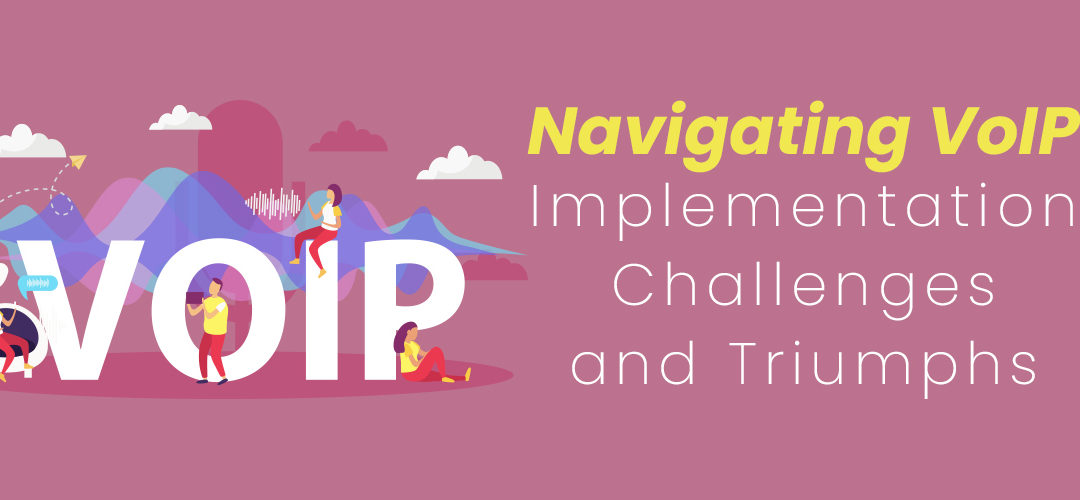VoIP (Voice over Internet Protocol) implementation is a complex process that requires careful planning and execution. With the increasing demand for remote work and virtual communication, more and more businesses are turning to VoIP as a cost-effective and flexible solution. However, navigating the challenges and triumphs of VoIP implementation can be overwhelming without the right knowledge and expertise.
One of the biggest challenges of VoIP implementation is ensuring a smooth transition from traditional phone systems. This involves assessing the current infrastructure, selecting the right VoIP provider, and ensuring that all necessary hardware and software are in place. Additionally, businesses must consider factors such as network security, call quality, and scalability to ensure that the system can meet their current and future needs.
Despite the challenges, VoIP implementation can bring significant benefits to businesses, including increased productivity, cost savings, and improved customer service. By leveraging the right technology and expertise, businesses can overcome the challenges and enjoy the triumphs of VoIP implementation. In this article, we will explore the key considerations for successful VoIP implementation and provide practical tips for navigating the process.
Planning for VoIP Implementation
When it comes to implementing Voice over Internet Protocol (VoIP), proper planning is essential to ensure a smooth transition from traditional phone systems. This section will explore the key considerations for planning a successful VoIP implementation.
Assessing Infrastructure Needs
Before implementing VoIP, it’s important to assess the current infrastructure to ensure that it can support the new system. This includes evaluating the bandwidth, network capacity, and security protocols. A VoIP readiness assessment can help identify any potential issues and ensure that the network is prepared for the new system.
Choosing the Right VoIP Provider
Selecting the right VoIP provider is crucial to the success of the implementation. It’s important to consider factors such as reliability, scalability, and cost when evaluating potential providers. Additionally, it’s important to choose a provider that offers features that align with the organization’s needs, such as call forwarding, voicemail, and conferencing.
Developing a Rollout Strategy
Developing a rollout strategy is essential to ensure that the implementation is successful. This includes identifying key stakeholders, establishing a timeline, and providing training to end-users. It’s important to communicate the benefits of the new system to employees and address any concerns they may have. Additionally, it’s important to establish a support system to address any issues that may arise during the transition.
In summary, a successful VoIP implementation requires careful planning and consideration of the organization’s infrastructure, VoIP provider, and rollout strategy. By taking these factors into account, organizations can ensure a smooth transition to VoIP and reap the benefits of this modern communication technology.
Overcoming VoIP Challenges
Implementing VoIP technology can be challenging for any organization. However, with careful planning and execution, these challenges can be overcome. In this section, we will discuss some of the most common challenges that organizations face when implementing VoIP technology and how to overcome them.
Ensuring Network Stability and Quality of Service
One of the biggest challenges of VoIP implementation is ensuring network stability and quality of service. Voice traffic is sensitive to network congestion, latency, and jitter, which can result in dropped calls, poor call quality, and other issues. To avoid these problems, organizations must ensure that their network is stable and capable of handling the additional traffic generated by VoIP.
To address this challenge, organizations should consider implementing Quality of Service (QoS) technologies. QoS technologies prioritize voice traffic over other types of traffic, ensuring that voice traffic is given priority on the network. Additionally, organizations should consider implementing network monitoring tools to identify and troubleshoot network issues before they impact call quality.
Addressing Security Concerns
Another challenge of VoIP implementation is addressing security concerns. VoIP traffic is vulnerable to eavesdropping, hacking, and other security threats, which can compromise the confidentiality and integrity of voice communications. To address these concerns, organizations must implement appropriate security measures.
Organizations should consider implementing encryption technologies to protect voice traffic from eavesdropping and other security threats. Additionally, organizations should implement access controls to restrict access to VoIP systems and prevent unauthorized access. Regular security audits and vulnerability assessments can also help identify and address security vulnerabilities in VoIP systems.
Managing Cost and ROI
Finally, one of the biggest challenges of VoIP implementation is managing cost and return on investment (ROI). VoIP implementation can be expensive, and organizations must carefully manage costs to ensure that the benefits of VoIP outweigh the costs.
To manage costs, organizations should consider implementing cost-saving measures, such as using open-source VoIP software, implementing virtualization technologies, and leveraging existing network infrastructure. Additionally, organizations should carefully track the ROI of VoIP implementation, including the cost savings and productivity gains achieved through VoIP technology. This will help organizations justify the investment in VoIP and ensure that the benefits of VoIP outweigh the costs.






